European History of Heraldry
 |
| Bayeux Tapestry, c1066 currently at the Centre Guillaume le Conquérant |
 eraldry made its first appearance more than 900 years ago in Europe that is still very much alive today not only in Europe, but in other continents as it was introduced by migrating and colonizing Europeans in the form of municipal arms, corporate arms and personal arms. Conventional wisdom indicates that the reason for the birth of heraldry was for the purposes of symbolically identifying the individual in times of war and tournament. The use of symbols (charges) and colours (tinctures) to decorate the warrior class (knights) shields can be found throughout paintings and illustrations sourced from the medieval period. Even as early as the 11th century, the famous Bayeux Tapestry depicting the Battle of Hastings of 1066, has some indications of early symbolic identifiers painted on the warrior's shield, and other images of one lifting his helm in order to ensure that the warriors recognize him as friend so as to not be attacked by his own men. Based on the numerous illuminations and art from the period, it would seem that the utilization of colorful symbols, painted on shields offered a manner of representation of the individual, given the armour worn would've concealed the wearer's face.
eraldry made its first appearance more than 900 years ago in Europe that is still very much alive today not only in Europe, but in other continents as it was introduced by migrating and colonizing Europeans in the form of municipal arms, corporate arms and personal arms. Conventional wisdom indicates that the reason for the birth of heraldry was for the purposes of symbolically identifying the individual in times of war and tournament. The use of symbols (charges) and colours (tinctures) to decorate the warrior class (knights) shields can be found throughout paintings and illustrations sourced from the medieval period. Even as early as the 11th century, the famous Bayeux Tapestry depicting the Battle of Hastings of 1066, has some indications of early symbolic identifiers painted on the warrior's shield, and other images of one lifting his helm in order to ensure that the warriors recognize him as friend so as to not be attacked by his own men. Based on the numerous illuminations and art from the period, it would seem that the utilization of colorful symbols, painted on shields offered a manner of representation of the individual, given the armour worn would've concealed the wearer's face.
It is suggested that the evolution of heraldry accelerated as the importance of tournaments grew in the culture of medieval Europe. Tournaments were held all over Europe, and would attract knights from all lands, including Germany, Italy, France, Belgium and England. The pageantry of tournaments rapidly
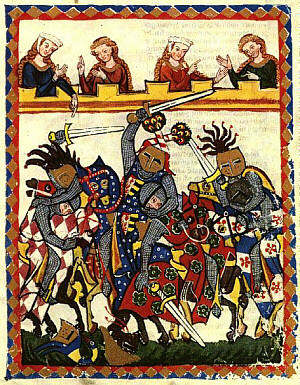 |
| The dukes of Anhalt in a mêlée (tournament) with single-handed swords. Universitätsbibliothek Heidelberg, MS Cod. Pal. Germ 848 (14th century) Die Manessesche Liederhandschrift. |
evolved during the later portion of the 14th century and into the 15th century, whereby the original purpose of the tournaments of providing opportunities to develop martial skills for combat morphed into a pageantry of pomp and colour, where the most important aspect of the tournament was to simply be there. The resulting elaborate colorful and exotic arms found on combatants' shields, extended to their garments, hence, their "coats of arms" worn by the combatants, also extended to the colorful caparisons [ 1 ] complete with symbols (devices) taken from the rider's heraldic achievement. Add to the elaborate accoutrements of a tournament combatant, the crest worn on the helm evolved into spectacular forms and shapes, becoming an important component of armorial bearings throughout history.
Slovenian History of Heraldry
The evolution and practice of the heraldry was not limited to Western Europe, given that heraldry played a significant role in the history of Slovenia.
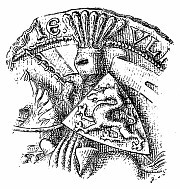 |
A seal of Ulrich III von Kärnten, dated
1256, depicting what may be a panther
on the shield. |
For example, in what was known as Kärnten (Carinthia), Goerz, Steiremark (Styria) and Krain (Carniola) - regions which encompass much of what Slovenia is today, the famous peacock - feathered crest adorned the helm worn by Leopold VI of Babenberg (c 1230) is visible in artifacts from that period including the royal seals. He was Duke of Styria in 1195, and from 1198, the Duke of Austria. The adorned helm with peacock feathers continued with Ulrich III of Kärnten (Carinthia), where in 1256 [ 2 ] (figure on right), he had adopted his father's ducal shield adorned with a heraldic beast which may be a stylized "panther" [ 3 ] and remained the heraldic beast until his death in 1269. In addition to the same heraldic beast, Ulrich's seal of the same year of his death depicts him on horseback wearing a tuft of peacock feathers as depicted on the right.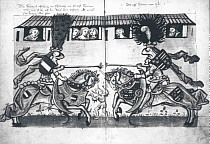 |
| A depiction of Count Frederik II of Celje jousting at a tournament illustrated in the Chronik des Constanzer Concils (1414-1418) |
The arms and armour illustrate the classic elements found in heraldic achievements. The knights are shown sporting decorative crests on their helmets which found their way into heraldic renderings of coats of arms. They also wear their coats of arms (shield only) displayed on what may appear as ailiettes [ 4 ] on their shoulders. However, there is a possibility of artist's liberty in the rendering of the tournament, in that each knight is illustrated with a single "aillette", meaning the object must be a shield. To add to the confusion, if this object is indeed a shield, then it is the wrong type of shield for a jousting match, as the shield would've normally be the tournament shield, with a notch on it to serve as a lance rest. The owner's arms are also displayed as well on the horses' caparsions and their crinet (part of their bard) [ 5 ], at the minimum, the tinctures of their coat of arms.
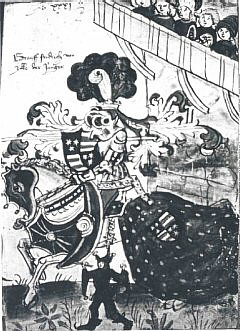 |
| An image of Count Frederik II of Celje at a tournament illustrated in the Chronik des Constanzer Concils (Chronicle of the Council in Constance, 1414-1418). |
In the south and central areas of what is now Slovenia, the region of Carniola existed, which also possessed a colourful history of heraldry. For example, the illustration on the right depicts Duke Frederika II (Grauff Fridrich von Zilli der Jünger) wearing classic tournament armour, and sporting a shield decorated with the colors of Carniola (blue "Azure", white "Argent" and red "Gules") [ 6 ] which today, form the official colours of the Slovenian national flag. The shield also has on the first and fourth quarters, three 6-pointed gold "Or" stars which belonged to the 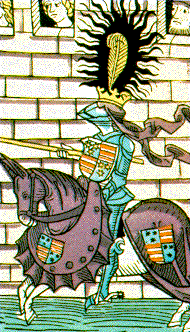 noble house of Celje first mentioned in the medieval annals around 1130. The stars today form the principle charges [ 7 ] of the coat of arms of Celje. A more recent color rendition on the left of the same clearly illustrates the "official" colors as well as the gold stars. The peacock feathers adorn the Count's helmet, which is consistent with the tradition of including feathers in the crest of armorial achievements in heraldic designs today.
noble house of Celje first mentioned in the medieval annals around 1130. The stars today form the principle charges [ 7 ] of the coat of arms of Celje. A more recent color rendition on the left of the same clearly illustrates the "official" colors as well as the gold stars. The peacock feathers adorn the Count's helmet, which is consistent with the tradition of including feathers in the crest of armorial achievements in heraldic designs today.
Another example of medieval heraldic influence on modern Slovenia is the Gorizia area, where the arms which presently make up the coat of arms for the province of Gorizia can be traced back to the headstone of Leonhard, the Count of Goerz found in the Cathedral of Gorizia dated approximately the end of the 15th century (left below). 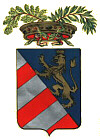 Aside from the highly evolved armour which appear similar to the style of harnesses constructed by Lorenz Helmschmied, Augsburg, (c1471-1532), Leonhard is depicted as holding a shield in his left hand which shows a heraldic lion on the right portion of the shield, and horizontal bands on the left. A similar armorial can be seen on the standard, held by his right hand. The Goerz family had moved to its principal residence in Gorizia sometime around 1120, and assumed the name of Counts of Goerz. [ 8 ] Through the next few hundred years of expansion and decline, ending with the death of Leonhard, who died without heirs, the territories of the family passed onto the Habsburgs. A modern-day rendition of the coat of arms for the Province of Gorizia can be seen on the right.
Aside from the highly evolved armour which appear similar to the style of harnesses constructed by Lorenz Helmschmied, Augsburg, (c1471-1532), Leonhard is depicted as holding a shield in his left hand which shows a heraldic lion on the right portion of the shield, and horizontal bands on the left. A similar armorial can be seen on the standard, held by his right hand. The Goerz family had moved to its principal residence in Gorizia sometime around 1120, and assumed the name of Counts of Goerz. [ 8 ] Through the next few hundred years of expansion and decline, ending with the death of Leonhard, who died without heirs, the territories of the family passed onto the Habsburgs. A modern-day rendition of the coat of arms for the Province of Gorizia can be seen on the right.
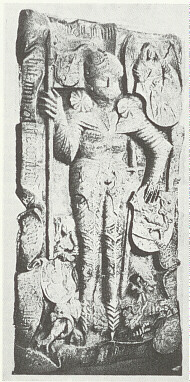 |
Headstone of Leonhard, Count of Goerz
located in the Cathedral of Gorizia,
15th century |
The closest thing to the existence of a "herald" at that period is the roll of arms in the book entitled "Heraldic Insignia and Devices" or "Opus Insignium Armorumque" containing an archive of 2041 superb paintings of coats of arms symbolizing the notable families in the regions of Slovenia and Austria. The arms were originally sketched by Janez Valvasor, and later painted by the heraldic artist Bartholomaeus Ramschisslu, creating this magnificent book around 1688. A more deserving account of the man behind the incredible contribution to Slovenian heraldry follows.
The baron Janez Vajkard Valvasor (1641-1693), who became a member of the Royal Society in London in 1687, was a polymath or, more precisely, a historiographer, geographer, ethnographer, cartographer, naturalist and technician; moreover, he was a collector, sketcher and publisher as well as a soldier and military commander. Valvasor's ancestors originated from the province of Bergamo in northern Italy.
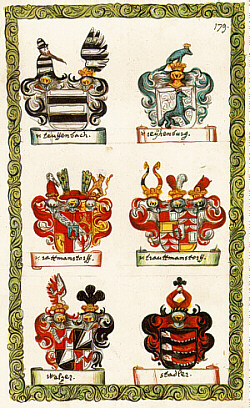 |
| Janez Vajkard Valvasor. Opus Insignium Armorumque 1687 - 1688 Das Grosse Wappenbuch |
These ancestors settled in the one-time crown land of Carniola, the central region of the present-day Republic of Slovenia, in the l6th century. Their family's country seat was the Medija castle near Zagorje. Janez Vajkard was born in 1641 in the region's capital Ljubljana, where he was baptized on May 28th of the same year and where he was educated at the Jesuit grarnmar school.
From his childhood he distinguished himself with great eagerness for research, universal scientific interest and strong patriotism. When he realized during his journeys that his country was very little known abroad or was not known at all, he conceived the idea of presenting Carniola to the world in words and pictures. . . Beside Carniola, Valvasor also wrote descriptions of Carinthia and published instructional and literary works of art.
From 1679 to 1689 Valvasor wrote and published the following works: Dominicae passionis icones, Topographia Ducatus Carnioliae modernae, Topographia arcium Lambergianarum, Ovidii Metamorphoseos icones, Topographia Archiducatus Carinthiae modernae, Topographia Carinthiae 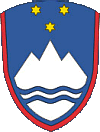 |
| Slovenia's coat of arms |
Salisburgensis, Theatrum mortis humanae tripartitum, Topographia Archiducatus Carinthiae antiquae et modernae completa, Die Ehre des Hertzogthums Crain. He prepared in manuscript two more treatises on natural history: Lumen naturae and Flos physicomathematicus, these works have not been preserved to date - and a heraldic album under the title Opus Insignium Armorumque, which contains paintings of more than 2,000 coats of arms, an example depicted on the right.
Heraldic bearings continued throughout the history of Slovenia leaving an indelible mark on the modern day country in the areas of vexillology (flags), municipal coats of arms, and historical artifacts depicting elements of arms of notable historical Slovenian families. Obvious evidence of this influence is visible in Slovenia's coat of arms, [ 9 ] depicting three six-pointed stars, which can be traced in origin to the noble family counts of Celje in accounts dating back to 1130. The family's court in the city of Celje had become the center of humanist thought and of the Renaissance in central Slovenia at that time and continued for centuries until the Celje dynasty was brought to an end in the mid-15th century. Such powerful symbols presented within the context of heraldic arms continue to find there place in Slovenia today as evidence by the three 6-pointed stars on Slovenia's modern coat of arms, and its official colors of blue, red and white originally sourced from the colors of the nobility of Celje from the medieval period.
Footnotes
- The caparison were ornamental blankets or covers for the horse which at the minimum, displayed the tinctures of the owner's coat of arms. These caparison were often decorated with the owner's coat of arms.
- Siegenfeld, Alfred Ritter Anthony von. Das Landeswappen der Steiremark. Graz, Verlags-Buchhandlung Styria, 1900. - tafel 11, 25 - 1256, 6. April, ,,apud Lutigiam". - Aus dem Siegel III B3 (Stempel 3) herzog Ulrichs III. von Känten nach dem Drig. im Stißtsarchio zu Reun. - Zu S. 37, 120, 180, Unm., und S. 255.
- Although there are some post-medieval historical documentation evidence and medieval artifacts that imply a "panther" as the heraldic beast depicted on the coat of arms of Leopold VI and later Ulrich III, at this time, there is no evidence in the form of direct textual period documentation (blazon) supporting dr. Jožko Šavli's proposal that the heraldic beast is that of a "black panther", thus having to rely on the power of interpretation of illustrations, which is not an "exact science". See the historical coats of arms in the roll of arms on this website for arms representing the Counts of Peilstein, in particular, the family BERNED (c1398) which depicts a black panther on the arms, is sourced from Siegenfeld, Alfred Ritter Anthony von. Das Landeswappen der Steiremark, 1900 and which is identified as one of the principle sources supporting his proposal.
- The ailette were a flat plate of hardened leather or parchment which was afixed to an arming point (leather thong or thread) on the shoulder. These were typically worn between 1250 - 1350 to display the owner's coat of arms.
- The crinet was a component of the horse's bard (full horse armour) which offered a defense for the horse's neck. In the image, the owner's coat of arms are displayed on the horse's crinet.
- The colours of heraldry, known as " tinctures" form the foundation of the language of heraldry known as "blazon". Coats of arms are rendered from the blazon, which is a language that originated with the nobles of Normandy and which have survived hundreds of years and is still in use today, at the various heraldic authorities for the registration and grants of official coats of arms.
- A charge is any object or figure placed on an heraldic shield or on any other object in an armorial composition; the shield or other object on which the charge is placed is said to be "charged". J.P.Brooke-Little. Boutell's Heraldry. Frederick Warne & Co. Ltd., London and New York, 1973. ISBN 0 7232 1708 4.
- A colour rendition of the coat of arms of Goerz can be found in the historical roll of arms on this website. The arms were illustrated in an armorial known as the Goriško Armorial, 1857 currently residing in the Goriško Museum at Kromberk Castle.
- An official description and definition of Slovenia's coat of arms can be found at Republic of Slovenia, Public Relations and Media Office, along with a description of the symbolism of the coat of arms available at Slovenian coat-of-arms.
Bibliography
- Ulrich von Richtental. Chronik Des Constanzer Concils. 1414-1418
- David Edge & John Miles Paddock. Arms & Armor of the Medieval Knight. Crescent Books, NY 1996. ISBN 0-517-10319-2
- Siegenfeld, Alfred Ritter Anthony von. Das Landeswappen der Steiremark. Graz, Verlags-Buchhandlung Styria, 1900.
- Cankarjeva založba, Ljubljana, Zgodovina Slovencev. 1979
- Peter Gwynn-Jones. The Art of Heraldry - Origins, Symbols and Designs. Parkgate Books Ltd., 1998
- Posta Slovenije d.o.o., 1993 Stamps, 300th anniversary of death of Janez Vajkard Valvasor, written by Prof. Dr. Branko Reisp
- Janez Vajkard Valvasor, Opus Insignium Armorumque 1687 - 1688 Das Grosse Wappenbuch, re-printed by the Slovenian Academy of Sciences and Arts, January 1993 (999 copies only), ISBN 86-7131-070-1.
- dr. Jožko Šavli. Slovenia: Discovering a European Nation. Studio RO - Humar d.o.o., 2004
David M. Cvet
Slovenija Branch
February 2005
Copyright © All Rights Reserved Slovenija Branch
Released: October 28, 2008 Updated: October 28, 2008
Updated: October 28, 2008


 eraldry made its first appearance more than 900 years ago in Europe that is still very much alive today not only in Europe, but in other continents as it was introduced by migrating and colonizing Europeans in the form of municipal arms, corporate arms and personal arms. Conventional wisdom indicates that the reason for the birth of heraldry was for the purposes of symbolically identifying the individual in times of war and tournament. The use of symbols (charges) and colours (tinctures) to decorate the warrior class (knights) shields can be found throughout paintings and illustrations sourced from the medieval period. Even as early as the 11th century, the famous Bayeux Tapestry depicting the Battle of Hastings of 1066, has some indications of early symbolic identifiers painted on the warrior's shield, and other images of one lifting his helm in order to ensure that the warriors recognize him as friend so as to not be attacked by his own men. Based on the numerous illuminations and art from the period, it would seem that the utilization of colorful symbols, painted on shields offered a manner of representation of the individual, given the armour worn would've concealed the wearer's face.
eraldry made its first appearance more than 900 years ago in Europe that is still very much alive today not only in Europe, but in other continents as it was introduced by migrating and colonizing Europeans in the form of municipal arms, corporate arms and personal arms. Conventional wisdom indicates that the reason for the birth of heraldry was for the purposes of symbolically identifying the individual in times of war and tournament. The use of symbols (charges) and colours (tinctures) to decorate the warrior class (knights) shields can be found throughout paintings and illustrations sourced from the medieval period. Even as early as the 11th century, the famous Bayeux Tapestry depicting the Battle of Hastings of 1066, has some indications of early symbolic identifiers painted on the warrior's shield, and other images of one lifting his helm in order to ensure that the warriors recognize him as friend so as to not be attacked by his own men. Based on the numerous illuminations and art from the period, it would seem that the utilization of colorful symbols, painted on shields offered a manner of representation of the individual, given the armour worn would've concealed the wearer's face.




 noble house of Celje first mentioned in the medieval annals around 1130. The stars today form the principle charges [ 7 ] of the coat of arms of Celje. A more recent color rendition on the left of the same clearly illustrates the "official" colors as well as the gold stars. The peacock feathers adorn the Count's helmet, which is consistent with the tradition of including feathers in the crest of armorial achievements in heraldic designs today.
noble house of Celje first mentioned in the medieval annals around 1130. The stars today form the principle charges [ 7 ] of the coat of arms of Celje. A more recent color rendition on the left of the same clearly illustrates the "official" colors as well as the gold stars. The peacock feathers adorn the Count's helmet, which is consistent with the tradition of including feathers in the crest of armorial achievements in heraldic designs today.
 Aside from the highly evolved armour which appear similar to the style of harnesses constructed by Lorenz Helmschmied, Augsburg, (c1471-1532), Leonhard is depicted as holding a shield in his left hand which shows a heraldic lion on the right portion of the shield, and horizontal bands on the left. A similar armorial can be seen on the standard, held by his right hand. The Goerz family had moved to its principal residence in Gorizia sometime around 1120, and assumed the name of Counts of Goerz. [ 8 ] Through the next few hundred years of expansion and decline, ending with the death of Leonhard, who died without heirs, the territories of the family passed onto the Habsburgs. A modern-day rendition of the coat of arms for the Province of Gorizia can be seen on the right.
Aside from the highly evolved armour which appear similar to the style of harnesses constructed by Lorenz Helmschmied, Augsburg, (c1471-1532), Leonhard is depicted as holding a shield in his left hand which shows a heraldic lion on the right portion of the shield, and horizontal bands on the left. A similar armorial can be seen on the standard, held by his right hand. The Goerz family had moved to its principal residence in Gorizia sometime around 1120, and assumed the name of Counts of Goerz. [ 8 ] Through the next few hundred years of expansion and decline, ending with the death of Leonhard, who died without heirs, the territories of the family passed onto the Habsburgs. A modern-day rendition of the coat of arms for the Province of Gorizia can be seen on the right.

